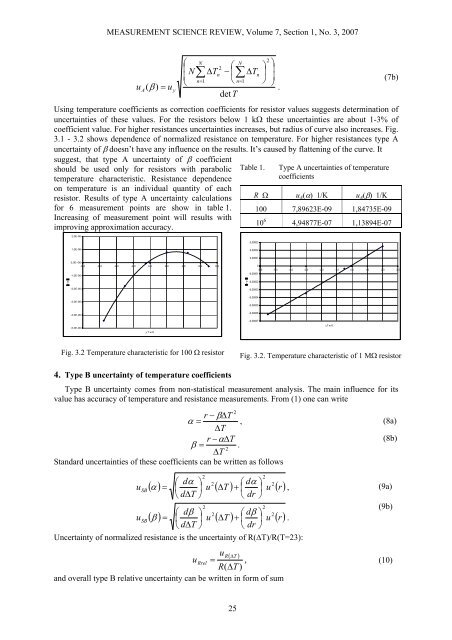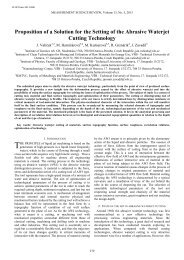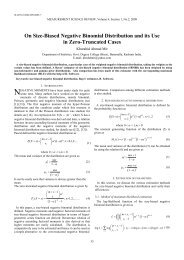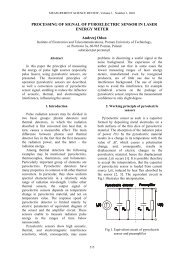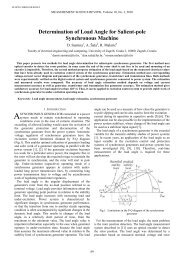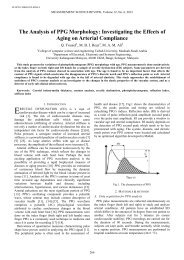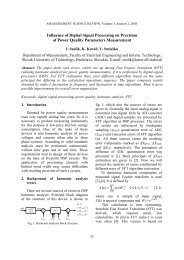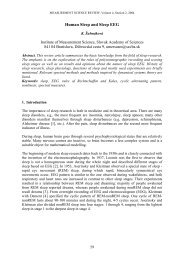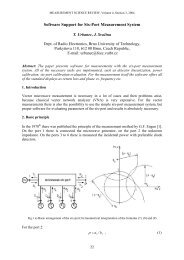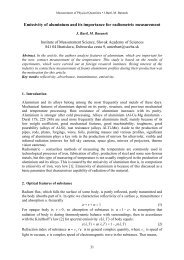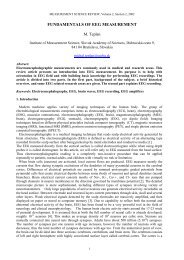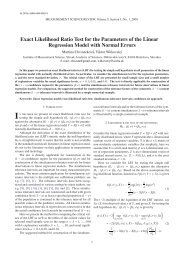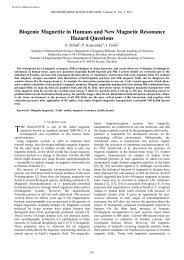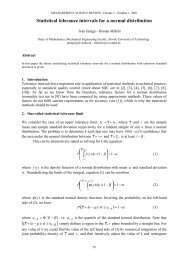Uncertainties of resistors temperature coefficients - Measurement ...
Uncertainties of resistors temperature coefficients - Measurement ...
Uncertainties of resistors temperature coefficients - Measurement ...
You also want an ePaper? Increase the reach of your titles
YUMPU automatically turns print PDFs into web optimized ePapers that Google loves.
MEASUREMENT SCIENCE REVIEW, Volume 7, Section 1, No. 3, 2007NN2⎛⎞⎜2 ⎛ ⎞N TnT ⎟n⎜ ∑ ∆ − ⎜∑∆ ⎟⎟n=1n 1uA() u⎝ ⎝ = ⎠β =⎠y.detTUsing <strong>temperature</strong> <strong>coefficients</strong> as correction <strong>coefficients</strong> for resistor values suggests determination <strong>of</strong>uncertainties <strong>of</strong> these values. For the <strong>resistors</strong> below 1 kΩ these uncertainties are about 1-3% <strong>of</strong>coefficient value. For higher resistances uncertainties increases, but radius <strong>of</strong> curve also increases. Fig.3.1 - 3.2 shows dependence <strong>of</strong> normalized resistance on <strong>temperature</strong>. For higher resistances type Auncertainty <strong>of</strong> β doesn’t have any influence on the results. It’s caused by flattening <strong>of</strong> the curve. Itsuggest, that type A uncertainty <strong>of</strong> β <strong>coefficients</strong>hould be used only for <strong>resistors</strong> with parabolic<strong>temperature</strong> characteristic. Resistance dependenceon <strong>temperature</strong> is an individual quantity <strong>of</strong> eachresistor. Results <strong>of</strong> type A uncertainty calculationsfor 6 measurement points are show in table 1.Increasing <strong>of</strong> measurement point will results withimproving approximation accuracy.2,0E-06Table 1.Type A uncertainties <strong>of</strong> <strong>temperature</strong><strong>coefficients</strong>R Ω u A (α) 1/K u A (β) 1/K0,00003(7b)100 7,89623E-09 1,84735E-0910 6 4,94877E-07 1,13894E-071,0E-060,000020,000010,0E+00-1,0E-06-8,0 -6,0 -4,0 -2,0 0,0 2,0 4,0 6,0 8,00-0,00001-6,0 -5,0 -4,0 -3,0 -2,0 -1,0 0,0 1,0 2,0 3,0r wr w-0,00002-2,0E-06-0,00003-0,00004-3,0E-06-0,00005-4,0E-06-0,00006-0,00007-5,0E-06∆T w K∆T w KFig. 3.2 Temperature characteristic for 100 Ω resistorFig. 3.2. Temperature characteristic <strong>of</strong> 1 MΩ resistor4. Type B uncertainty <strong>of</strong> <strong>temperature</strong> <strong>coefficients</strong>Type B uncertainty comes from non-statistical measurement analysis. The main influence for itsvalue has accuracy <strong>of</strong> <strong>temperature</strong> and resistance measurements. From (1) one can write2r − β∆Tα = , (8a)∆Tr −α∆T(8b)β = .2∆TStandard uncertainties <strong>of</strong> these <strong>coefficients</strong> can be written as follows2⎛ dα⎞ 2 ⎛ dα⎞ 2u SB( α ) = ⎜ ⎟ u ( ∆T) + ⎜ ⎟ u () r , (9a)⎝ d∆T⎠ ⎝ dr ⎠22(9b)⎛ dβ⎞ 2 ⎛ dβ⎞ 2u SB( β ) = ⎜ ⎟ u ( ∆T) + ⎜ ⎟ u () r .⎝ d∆T⎠ ⎝ dr ⎠Uncertainty <strong>of</strong> normalized resistance is the uncertainty <strong>of</strong> R(∆T)/R(T=23):uR( ∆T)uRrel= , (10)R( ∆T )and overall type B relative uncertainty can be written in form <strong>of</strong> sum225


